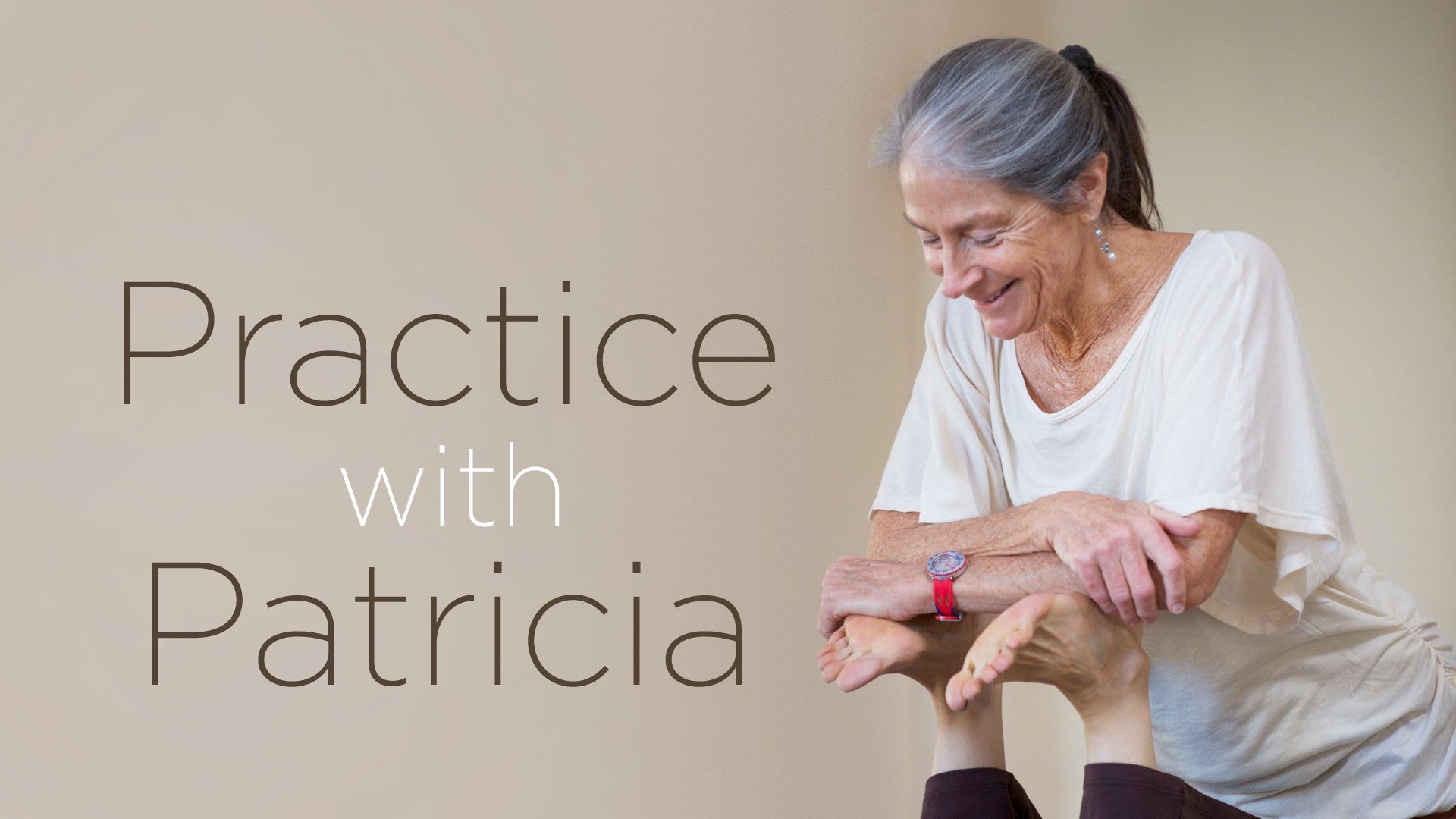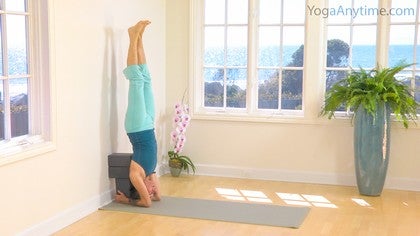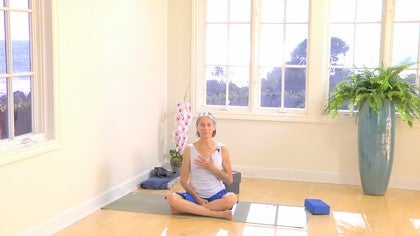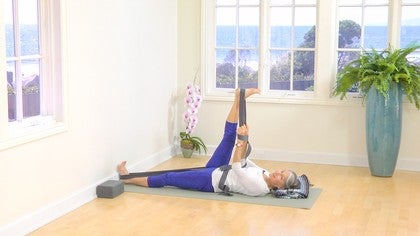Description
About This Video
Transcript
Read Full Transcript
So we're going to start this next sequence which will be moving towards ustrasana with all these with the preliminary half of this pose this sequence and then coming down from it. But I also want to do a short chant which you can join me in. We often do this in the beginning of my class at home. Other chants, this is a favorite. Om Ghatte Ghatte Paraghatte Parasam Ghatte Bodhi Svaha. It's at the end of the Buddhist Heart Sutra and it's considered to be a miraculous mantra, the great bright mantra, the supreme mantra, the mantra that is true and not false and it saves one from suffering and the mantra says in this form of it Ghatte means gone. Gone, gone and then Paraghatte gone beyond, Parasam Ghatte really gone beyond, gone beyond beyond and then Bodhi Svaha. Bodhi is the same, comes from the same root that the Buddha comes from it. So we're going and Buddha means the awakened one. So we go beyond, we don't leave our world, we don't leave ourselves but we're going beyond our limited version of ourselves and the world, okay. And sometimes people translate this more as an imperative, go, go, go beyond or let go, let go, let go totally. So whatever way speaks to your heart, it's not so much about the correctness of the grammar of this word Ghatte as it is what helps you to go beyond your limited version of yourself. So here's the tune and I'll end with an om, it's pretty simple. Starting with a deep in-breath and letting it out. Om Ghatte, Ghatte, Paraghatte, Parasam Ghatte, Bodhi Svaha, Om Ghatte, Ghatte, Paraghatte, Parasam Ghatte, Bodhi Svaha. And then one more. Om Ghatte, Ghatte, Paraghatte, Parasam Ghatte, Bodhi Svaha, Om. So the vowels in Sanskrit are said to be opening us and helping us to experience and go out into the vastness and gather ourselves, our consciousness. And then when we close our mouth around something like the M, it's sealed inside of us, all that is sealed inside. So I equate this letting go to letting love in and Rumi has a beautiful short poem. I let love in and became fierce like a lion and tender like an evening star. So it has both qualities. All right, so we're moving towards camel and camel is a big heart-opening and we'll work with some things to help us be ready to do that. And I think we're going to start with cat and cow. And we'll just move our sitting blanket back and hands underneath the shoulders, your knees underneath your hips. Inversions you can do this differently but let's just stay with this for now. Inhale and as you exhale, tilt your pelvis, lower back, stretching, abdominal wall, pressing back, dropping your head, tailbone and crown reaching towards each other. Dip, turn the tailbone up, sink your spine in, let your shoulder blades kiss, lift your head, tailbone and pelvis move, the rest of the body responds, tailbone and pelvis move, the rest of the body follows. One more. Exhale, pressing firmly back through the abdomen. Inhale in place, exhale drop, inhale in place. Good. And so then we're gonna come into downward dog after that. Sometimes just a little bit of wrist release is nice. In your downward facing dog pose, you're going to come from the cow-like shape. Turn your toes under, lift your hips and this will help you to keep the tailbone lifting as you stretch back into the pose. And then you want to adjust for those of you who can really overdo the pose. You don't need to do that. So you can just move your ribs away from the floor and move them towards your back body and up towards your hips.
So I'm reaching towards the floor from my outer arms and I'm allowing a sense of everything coming back up from the inner arms. I'm reaching towards the ground from my outer and back legs and I'm allowing a sense of coming up from the inside. Exhale and come down. Okay good. So again a little shakeout if you need. We're gonna start to, we're gonna come up and start to work with an uttanasana-like pose. And in this uttanasana it's also very helpful to have the connection to the earth and sometimes just pushing down on your own legs. It's like oh yeah I'm there. I forgot. And then just like when a tree connects and roots, which it does naturally, the earth sends her energy back up, her juice back up. So it's coming up the inner legs and right up through the core of the body and then it can circulate back down again. Okay so imagine that there's a wave coming up the inner legs and it's going to help you to lift your pelvis off of the thighs and the crease here slowly deepens back, spine staying straight for as long as you're able to do that. If you need to bend your knees that's fine. Okay and so from this standing forward bend we're just going to loosen a little bit bringing the left hand across towards the right and turning up. And this elbow moving back helps to stretch and open this side of the body. Inhale here, exhale across to the other side, hand to the hip, turning, opening the front. Exhale across and back up. Inhale into the opening this time. Let the arm come up. Each time I move from side to side I switch which knee is bent. So you can see that the side I'm turning away from my left knee is bent. If you have to have this other knee bent have the left one more bent. Inhale here. As you turn down you change which knee is bent. I'm turning towards the straight leg. Inhale in place. Exhale both knees are bent for a moment and then the side you're turning to that knee straightens. Inhaling up. So we're getting some opening in that upper chest along with the rotation. Y rotation on the way into a back bend. Okay, that's my last one. And I'm going to bend the knees and come back up. Because the rotation starts to make the spine more supple. So the back bending is a bit more accessible by doing that sort of thing. Now we're going to work with opening the front a little bit more vigorously. If you are able to interlace your fingers and keep your shoulders from going into a position like that. So first of all you might be able to interlace your fingers behind your back and and not have the shoulders cramp up on you. But you also might have difficulty raising the hands without the shoulders going into a position where they're where they're cramped up. If that's true for you, if lifting the hands back then actually means you're not open anymore but you're actually closing like that instead of this, then you're going to use the belt. So you'll open your belt out and it's it's it can be helpful to have a loop in it. And you can just slip your hands into the loop. You can see that my palms are facing the front of my body. So and you can hold it if you like but it'll stay in place. So you're here, you're upright, you're letting the shoulder blades come towards each other and then you're going to lift your hands away from the hips and buttock. That already is a really strong stretch and it's so strong that it might throw your lower ribs forward. So notice that and you can actually allow that at first because it does enhance. If I restrain this right away I might go right back to this position. I'm not going to restrain it right away. I'm going to let the ribs poke forward. I love going against convention once in a while. Okay so then after you hold that for a little bit then come back and then see if you can keep this this midsection a little more quiet as you lift. Maybe you can't lift as much that's okay. You're going to take a deep breath here and then keeping the hands lifting we're going to take that forward bend just like we did a moment ago and however far you can go down without going into the rounding of the spine go that far and just hold for a moment. Your legs are firm connecting in with the downward circuit downward reach of the outside legs and upward reach of the inside legs and then you're going to allow your arms to curl in the other direction. See how my hands have turned? You're no longer this way. Your knees can be bent and you're just letting gravity pull on the arms. And then you're going to do something you just did a while ago which is to bend one knee and turn your body. So if something that can happen here is that you can actually open that shoulder on that side. It doesn't have to stay like this. You can open it and then you bend the knee that was straight and you go across to the other side and you open that one. Inhale as you exhale we make the transition. The side I'm turning to the knee is straight. I'm twisting my arm and opening the shoulder and we'll do one more side on the other side bending both knees. Now the side I'm turning to the knee is straight. Arm turns up back to the center. Bend your knees. Take an in-breath here part way up. Exhale come up the rest of the way. So I'm being cautious by bending the knees and by breathing in and staying halfway and then breathing out and coming up the rest of the way. That helps some people get sort of dizzy and lightheaded coming up after that sort of thing. So by inhaling part way up and then exhaling you've already fed your brain some oxygen. You've already allowed some of the blood to come out of the head area. Okay so that's that lightness and openness of the upper body that's going to be so helpful in your camel pose. And now just for a little bit of spaciousness in the hips. So this is a multi-use pose squat. I use it a lot for different different kinds of awarenesses and openings. In this one we're gonna rather than utkatasana with the knees forward which is very strengthening to the knees I want to bring the focus more back into the hips by bringing the knees back. So I'm not letting them go forward. I'm keeping them back which means I have to take my hips back. This is very useful. Put your hands on the outsides of your knees. Press in but don't let the legs come in and that causes the the lever of the thigh bone to move laterally. So your upper thigh bones are moving laterally in the hip socket and then to hold that there in place as you let go your hands that really gives some openness and space and strength stability at the same time. Don't over arch your back so again these these front ribs might get overactive because of the activity here so you're gonna just soften back, flower out, back in the back and then stretch your arms forward and let the shoulder blades come down your back. Breathing, widening, imagine separating your sit bones and the thigh bones but not the knees. If you're a little stronger in the low back you can take the arms up but believe me this does take more work in the low back. Keep the lower ribs back so one of these two positions if this is too hard on your lower back hug your hug your arms in. It takes if you're still working your hips but you're not hurting your low back.
Okay good and then back up to standing. So so yes that one has given us some strength and opening here and you want to just keep that base of the skull open as you take a breather and pause here. So we've we've just you know flexed our hips we've we've closed the space that we need to have open for the ustrasana so I'm just gonna give you a chance to extend there for a moment and if you just take take your foot back you can stand on the tippy toes or stand on the bottoms of the toes or even the toenail polished side of the toes and you're stretching down through the thigh and coming forward from the pelvis and lifting so the wheels are turning and that turns on the buttock and the hamstring which will be very helpful in the ustrasana pose and you won't have to struggle through this opening when you're coming into the ustrasana. Okay so that just takes a few moments and standing on the other leg, foot back, stand on the inner thigh of your standing leg, breathe open and lift, ribs are softening back, firming back really, firming back, it softens your back, it's firm in the front, it softens the back. Okay so just a little wee opening here and the hips which will come along very nicely. Now maintain that sense of opening the turning of the wheels and let's just work on standing what we're gonna do with the chest in ustrasana. You're going to be rolling the collarbones up and over your back as though it's a waterfall. You're going to be firming the lower ribs back so that your lower back can stay soft. So it's really just a very vertical lift of the chest and you can see that I'm not taking my head all the way back. I'm just, it's just like the lotus can float right up out of the heart.
Okay with the grounding. All right so just do a little stretch out rest just for a few moments. Sometimes I think of this as a half dog. Just lengthen the spine and you can work with moving the belly back and getting again the sense of where that comes from. Where that strength comes from. That prevents over overarching here. Okay so here we go in the ustrasana. I like to use a blanket even though this is a pretty dense little mat here. This part of the knee is the joint. So the shin bone and thigh bone and joint. So you're standing right on the joint. I'm very sensitive to, I have very sensitive knee joints. So and turns out a lot of people my age do. So this is a nice thing to do and then you take your feet back and you want the sticky mat for your feet. There's a wonderful little foot grounding thing you can do which is to slightly move your toes towards the edge of the mat. Which you can see brings a little arch to my instep. But then as you push and reach the toes back you're turning the heels away from each other. And this stabilizes the pelvis. And already I can feel myself lifting here. Okay just by creating this activity with my feet I feel more stable in the pelvis and I can I can lift my hip points. Okay and I can I can feel then there's that impetus. I know where I'm going. I know I'm going towards ustrasana and that's coming into play too. So here we go. First movement into the pose. Taking it gradually while lifting the hips. Opening the space here. Feeling the hamstring coming up to meet the buttock. There's a lot of belly work here so that I don't have to do it all from the back. And there's this firming back so my back stays soft. And there's this sprouting from the heart. It's quite lovely to think of it as like a fountain. It just comes back up and down into oneself. It's that letting that love in and then you can reach back. Now you don't have to lay the head all the way back. Just reach back. And then come forward and up. Alright so I'm going to turn around so you can see it from the back and I'm going to show you how two blocks might come in handy here. So you line the blocks up with your heel and ankle and lower shin bone rather than putting them out behind you. I know it feels like you're reaching a yard or two back but you're really not going very far back at all. So I have really long arms but look I don't even have to do a back bend to reach here. So you're going to create all these movements of moving into the earth, working with the foot, getting that stability, allowing the back to be spacious by lifting from the front hips, softening, firming back from the ribs. I often will just stay like this for a while. So this is opening. It's not outrageous. I can talk here and yet it's very open. And as I continue that opening it's not so difficult to reach back. And you can lean on the blocks. You can even let your hips come back a little. Push off. And then this can turn into just another half dog because this gives some traction. And if you might want to be doing a second ustrasana you don't want to go into rounding the spine just yet. You just want to elongate. And then I want to show you a third way now that you've seen my back. So some of us baby boomers and beyond. Our necks are rather delicate. And so I have some people in my classes who like to stand on their toes so that gets them closer to the wall. They may or may not use the blocks. All the same work coming into earth, earth presence, earth grounding, receiving the gift back, letting it come up, and it just moving towards the opening. The nice thing here is I can actually press on the wall with the balls of my feet. That is so stabilizing. And holding the ribs and just finding out can can my head find the wall before any problem comes up with the neck or the lower back or anything. And it just takes a lot of to be supported like this. It makes it possible for a lot of people for whom it might not be otherwise. Okay. Back to half dog. Breathe into your belly. And curl. Okay. So a really nice, you could do a child's pose here and Supta Padangusthasana in a kind of a simplified version. So on the back, since we have the wall, we're going to use it. As I lie down and make sure that I can get a strong push into the wall, if I'm just a little too far away I'm going to have to, I'm going to have to, you know, side stretch my hip to get down there. So I want to not have to do that. Hug in Pavan Muktasana, the wind regulating pose. So this calms the winds of the body, which might have gotten kind of excited after doing Ustrasana. And then from here, coming up into, if you're not able to get the legs straight here, it's okay. You can just hold at your knee and curl up. When you curl up, think about using your belly. So inhale, exhale, the belly is moving back, and then you come up. And then two or three breaths here, sending the energy up and down the leg right through the marrow of the bones. So when you first learn about this movement, you can, it's very nice to think of it as coming from the outside of the body, but it's also really changes it when you move to the center of the bone and think about the marrow. So I'm moving the block over for my second leg, hugging in Pavan Muktasana, lengthening the back of a Mac. So softening the hip before straightening the leg up, holding on wherever. It could be very close, taking a breath. Exhale, let the belly and the ribs move back towards the floor and lift. So I'm rounding the upper back, but I'm not rounding the lower back. I'm actually making space in the lower back by doing this. So if we've compressed the lower back a little bit, which isn't kind of inevitable, it's, compression is not bad, it squeezes out old stuff, then you let go and fresh stuff comes in. So you let go of the Supta Padangusthasana. Both knees are bent, and actually we're going to roll over, trying not to crush the box here that keeps my vocal going, and we're going to come into Ardhamachandrasana. Actually in the Garanda Samhita, this is called Matsudrasana. So the half pose part of it came later. Sitting up on a height always enhances twisting. Fairly easy to get the back straight in Dandasana here, but one of what you're going to be doing in this pose is you're going to bend your knees and tuck one under in order to twist from the other side, and that tucking the leg up tends to drop the pelvis back and round the belly and the spine. So just coming up on this height helps, even for people who are pretty flexible. So I've gotten the left leg heel to the outside of my hip and the right leg comes across, and just sitting here feeling the balance of this, you may notice that your crossed leg is almost off the blanket. So settle down, settling down, and then press down on the knee, creating as much height so there's this sense of moving towards the earth and away and turning. Inhale, elongating through your spine, exhale, turn again. So take what your body is going to give you, don't force beyond. Your body may just be saying go easy, might be saying feed me more. So you try to learn that language. So crossing the arm by reaching and getting the hook of the the crook of the elbow across the outside of the knee.
Inhale, lengthening, exhale, turning a bit more. Now this arm here, like this, rather than across, actually prevents me from crunching down into my lower back. So sometimes you can do the elbow across, maybe if you just, you know, you have to watch yourself and make sure that the elbow across doesn't create that crunching down. Inhale, exhale, turn. Not forcing from the arms, but asking the spine and the belly to create the turn. And then one more breath, height of the spine, very important. Exhale, turn back towards the front and stretch the leg out. And just pause for a few moments with the legs straight. Okay, so for the second side, bend both knees a little bit first. Remember that you're going to be tucking the opposite leg under, so hopefully made a mental note that it was the left leg before. If not, I'm remembering for you. And then let's bring the left foot across. Okay, so for some people it's quite easy to get this foot very close to your hip. Fine, I like to keep it somewhere about halfway between. I feel there's a little more room for me to stay upright when I do the twist. So pressing down on the knee with both hands, lengthening up. That's the in breath, and then with the out breath, keep the right hand on your knee as you bring your left hand back. You still haven't turned your upper body very much. Inhale again, lengthening up, and reach your right arm, hook around the knee, the elbow around the knee, and then as you exhale, allowing yourself to turn. Imagine that you are able to look out and see a vast horizon, just a horizontal line between ocean and sky. See that from the inside, even if you can't see it from the outside. It's very calming, sometimes more calming if you're doing it from the inside. So your head is turning in the same direction you're facing the wall, turning, inhaling, lengthening up, exhaling, grounding, and turning. Until it's time to unwind. One more breath, turn your head back first, and then release the arm, unwind, stretch your legs out. Just feel what all that squeezing and turning in opposite directions is doing for the for your body and for your mind waves. They are becoming more like that vast horizon. So we're going to just do a couple things here as closing. I'm going to have the blocks near my hands for in the block behind my head for the closing part. But first is stretching out in starfish pose. So we've been doing all of this, you know, sort of restraining and opening and turning and squeezing and now we're just letting everything be open. And this can be so delicious. Back of your neck staying long. Opening the body is one way to prepare the field of awareness and consciousness to let that love in, to go beyond. And then we're going to bend the knees and bring the feet up and we're going to kind of tuck in and close in again, but this time in a very soft way. I'm going to stretch your legs almost all the way to the wall. Don't let the wall be in the way. We're going to use this block in just a second. Separate your heels far enough apart that when you roll your toes together, they don't quite touch. And let your knees move towards each other and wedge your blocks not under the knee, just above the knee on the thigh. And as you stretch your feet out towards the wall, you're rolling your inner thighs down towards the floor and these wedged blocks hold your legs in this inwardly rotated position. So we've just effectively closed the floor of the pelvis in this really soft, quieting way.
And sometimes you might want to wait a few seconds before you affix the head block because it might slip, but it feels pretty stable to me. So now I want to release the back of the skull after all that backward bending and all that opening. It's like the Aum. So the Aum, our consciousness goes out and gathers everything about us that's scattered and brings it back in and the Aum just seals it in. So this is like the the part of Aum right now, what we're doing here. So you're rolling, your forehead is higher than your chin, your chin is almost resting on your chest. Back of your neck should be just completely relaxed, but one hand on the belly to feel just just the innate presence of being alive, connected to the earth, one hand on the heart to allow that nourishment to settle in. Breathe into the belly and allow some of that opening to come into your heart, settling more deeply, letting go more deeply with each breath. Ghatte, Ghatte, Paraghatte, Parasam Ghatte, Bodhisvara. The sign that you're hopefully are feeling, that your practice was balanced, is that though there was some strenuous work, there's been enough resting and calming that now your breath is smooth, easily accessed into the belly and that your brain, mind and heart feel quiet. Sometimes in Shavasana or or in Pranayama meditation as well, you're still in your Shavasana. I imagine that the brain is sitting inside of an imaginary bowl and that it is settling into the bottom of that bowl with each breath, especially the out-breath, and so much so that even when I breathe in, it doesn't float towards the top of my skull, stays settled. So we'll do that for a few more breaths before we get up. So now you're going to reach back with your hands, move the block away, settle your head back down onto the mat, remove the leg blocks, and then just slowly feel hands and feet, fingers and toes, bending one knee, bending the other. A little pelvic tilting perhaps. Normally we roll to the right, I'm going to roll to the left right now, raising my arm up so that when I roll over to my side, that arm supports my head, then tucking the knees up a little bit more on the way up, using the free hand, stretching one leg back, letting the head come up last. So that poem by Rumi inspired a poem in me one morning, so I'm going to see if I can remember it and recite it to you.
From that poem, let that love in, be the presence, find the friend within. The friend who, without words, stands in you, listens into you, feels into you. Without words, never judging, always loving. You are that friend. Thank you. Namaste.
Practice with Patricia
Comments
You need to be a subscriber to post a comment.
Please Log In or Create an Account to start your free trial.

















